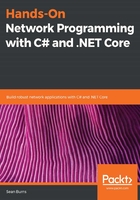
Star topology
Finally, we begin to consider network topologies more common in enterprise networks. The star topology is arranged in such a way as to produce an asterisk-like star shape, with each peripheral node connected by a single channel to a central hub-node, as demonstrated in the following diagram:

The hub of a star topology serves as a broker of communication between all peripheral nodes. It receives and forwards requests from each of its peripheral nodes by way of a direct, point-to-point connection.
This topology provides the benefit of isolating the failures of peripheral nodes or their connections to the hub to those nodes specifically. Each of the other nodes can maintain their connections to all the other nodes in the network with any one of them going down. It is also, at least conceptually if not physically, infinitely scalable. The only task necessary to add a node to the network is to add a link between the new node and the hub node.
Hopefully, by this point in the discussion of network topology, you'll already have identified the obvious downside to this approach. If the hub-node goes offline, the entire network is eliminated. From the perspective of any one peripheral node, loss of the hub means a loss of the entire network, since everything can only ever communicate with the hub.
In reading my description, you may have also realized that some network topologies can be decomposed into sub-networks of completely different topologies. A network defined by any given peripheral node and the hub node of a star topology is itself a single instance of a point-to-point network. Likewise, a network defined by any two peripheral nodes and the hub node of a star topology is technically a linear topology (which is itself a specialized implementation of the bus topology). By logically extending these simple diagrams into larger compositional topologies, we can describe any kind of network you could possibly write software for.